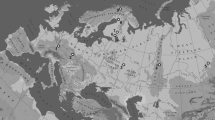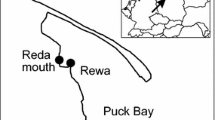Abstract
South Africa’s Prince Edward Islands support a large proportion (44 %) of the global Wandering Albatross Diomedea exulans breeding population, yet most breeding phenology data are recorded from smaller and geographically distant populations. Timing of breeding at Marion Island was remarkably constant across three successive years (2007–2009), providing a good baseline against which future changes can be assessed. Male (but not female) early arrival and presence at the colony during the pre-laying period was positively related to breeding success. Earlier hatching chicks were more likely to survive, but timing of egg laying and incubation periods did not influence fledging success. Although there was considerable individual variation in breeding phenology, average dates of male arrival, laying and hatching were later at Marion (47°S), Crozet (46°S) and Kerguelen (49°S) than at more southerly Bird Island, South Georgia (54°S). Earlier breeding at South Georgia may ensure that chicks have time to grow sufficiently to survive harsh winter conditions that set in earlier at South Georgia.



Similar content being viewed by others
References
ACAP fact sheet (2012) Wandering Albatross. http://www.acap.aq/en/acap-species/304-wandering-albatross/file. Accessed 3 Sep 2016
Barbraud C, Weimerskirch H (2006) Antarctic birds breed later in response to climate change. Proc Natl Acad Sci USA 103:6248–6251
Barbraud C, Weimerskirch H (2012) Estimating survival and reproduction in a quasi-biennially breeding seabird with uncertain and unobservable states. J Ornithol 152(Supplement 2):S605–S615
Boelhouwers JC, Meiklejohn KI, Holness SD, Hedding DW (2008) Geology, geomorphology and climate change. In: Chown SL, Froneman PW (eds) The Prince Edward Islands: land–sea interactions in a changing ecosystem. SUN Press, Stellenbosch, pp 65–98
Both C, Artemyev AV, Blaauw B, Cowie RJ, Dekhuijzen AJ, Eeva T, Enemar A, Gustafsson L, Ivankina EV, Järvinen A, Metcalfe NB, Nyholm NEI, Potti J, Ravussin P-A, Jose Sanz J, Silverin B, Slater FM, Sokolov LV, Török J, Winkel W, Wright J, Zang H, Visser ME (2004) Large-scale geographical variation confirms that climate change causes birds to lay earlier. Proc R Soc Lond B 271:1657–1662
Brooke M (2004) Albatrosses and petrels across the world. Oxford University Press, Oxford
Burg TM, Croxall JP (2004) Global population structure and taxonomy of the Wandering Albatross species complex. Mol Ecol 13:2345–2355
Charmantier A, Gienapp P (2014) Climate change and timing of avian breeding and migration: evolutionary versus plastic changes. Evol Appl 7:15–28
Charmantier A, McCleery HR, Cole LR, Perrins C, Kruuk LEB, Sheldon BC (2008) Adaptive phenotypic plasticity in response to climate change in a wild bird population. Science 320:800–803
Charmantier A, Buoro M, Gimenes O, Weimerskirch H (2011) Heritability of short-scale natal dispersal in a large-scale foraging bird, the Wandering Albatross. J Evol Biol 24:1487–1496
Cooper J, Weimerskirch H (2003) Exchange of the Wandering Albatross Diomedea exulans between the Prince Edward and Crozet Islands: implications for conservation. Afr J Mar Sci 25:519–524
Crawley MJ (2008) The R book. Wiley, Chichester
Crick HQP (2004) The impact of climate change on birds. Ibis 146:48–56
Croxall JP (1990) Constraints on reproduction in albatrosses. ACTA XX Congressus Internationalis Ornithologici, Christchurch, pp 279–3012
Fressanges du Bost D, Segonzac M (1976) Note complementaire sur le cycle reproducteur du grand albatros (Diomedea exulans) de l’isle de la Possession, archipel Crozet. Com Nat Franç Rech Antarct 40:53–60
Gibson JD (1967) The Wandering Albatross (Diomedea exulans): results of banding and observations in New South Wales coastal waters and the Tasman Sea. Notornis 14:47–57
Gremmen NJM, Smith VR (2008) Terrestrial vegetation and dynamics. In: Chown SL, Froneman PW (eds) The Prince Edward Islands: land–sea interactions in a changing ecosystem. SUN Press, Stellenbosch, pp 215–244
Højsgaard S, Halekoh U, Yan J (2006) The R package geepack for generalized estimating equations. J Stat Softw 15:1–11
Huyvaert KP, Anderson DJ, Parker PG (2006) Mate opportunity hypothesis and extrapair paternity in Waved Albatross (Phoebastria irrorata). Auk 123:524–536
Inchausti P, Weimerskirch H (2002) Dispersal and metapopulation dynamics of an oceanic seabird, the Wandering Albatross, and its consequences for its response to long-line fisheries. J Anim Ecol 71:765–770
Jones MGW (2011) Individual variation in reproductive success in the Wandering Albatross. Ph.D. thesis. University of Cape Town, Cape Town, p 129
Jones MGW, Ryan PG (2010) Evidence of mouse attacks on albatross chicks on sub-Antarctic Marion Island. Antarct Sci 22:39–42
Jones MGW, Ryan PG (2014) Effects of pre-laying attendance and body condition on long-term reproductive success in Wandering Albatrosses. Emu 114:137–145
Jones MGW, Techow NMSM, Ryan PG (2012) Dalliances and doubtful dads: what determines extra-pair paternity in socially monogamous Wandering Albatrosses? Behav Ecol Sociobiol 66:1213–1224
Jones MGW, Dilley BJ, Hagens QA, Louw H, Mertz EM, Visser P, Ryan PG (2014) The effect of parental age, experience and historical reproductive success on Wandering Albatross (Diomedea exulans) chick growth and survival. Pol Biol 37:1633–1644
L’Hyver M-A, Miller EH (1991) Geographic and local variation in nesting phenology and clutch size of the Black Oystercatcher. Condor 93:892–903
Ludwig JP, Summer CL, Auman HJ, Gauger V, Bromley D, Giesy JP, Rolland R, Colborn T (1998) The roles of organochlorine contaminants and fisheries bycatch in recent population changes of Black-footed and Laysan Albatrosses in the Northern Pacific Ocean. In: Robertson G, Gales R (eds) Albatross biology and conservation. Surrey Beatty Sons, Chipping Norton, pp 225–238
Lutjeharms JRE, Ansorge IJ (2008) Oceanographic setting of the Prince Edward Islands. In: Robertson G, Gales R (eds) Albatross biology and conservation. Surrey Beatty Sons, Chipping Norton, pp 17–38
Marchant A, Higgins PJ (1990) Handbook of Australian, New Zealand and Antarctic Birds. Oxford University Press, Melbourne
Nager RG, Van Noordwijk AJ (1995) Proximate and ultimate aspects of phenotypic plasticity in timing of great tit breeding in a heterogeneous environment. Am Nat 146:454–474
Nel DC, Taylor F, Ryan PG, Cooper J (2003) Population dynamics of the Wandering Albatross Diomedea exulans at Marion Island: longline fishing and environmental influences. Afr J Mar Sci 25:503–518
Parmesan C (2006) Ecological and Evolutionary responses to recent climate change. Annu Rev Ecol Syst 37:637–669
Paulian P (1953) Pinnipèdes, cétacés, oiseaux des iles Kerguelen et Amsterdam. Memoires de L’Institut Scientifique de Madagascar 8:111–232
R Development Core Team (2010) R: a language and environment for statistical computing. R Foundation for Statistical Computing. Vienna, Austria. www.R-project.org
Robertson CJR (1993) Survival and longevity of the Northern Royal Albatross Diomedea epomophora sanfordi at Taiaroa Head 1937–93. Emu 93:269–276
Ryan PG, Jones MGW, Dyer BM, Upfold L, Crawford RJM (2009) Recent population estimates and trends in numbers of albatrosses and giant petrels breeding at the sub-Antarctic Prince Edward Islands. Afr J Mar Sci 31:409–417
Ryan PG, Ferreira C, Perold V, Osborne A, Jones CW (2015) Failure to launch: evidence of protracted parental care in albatrosses. Seabird 28:48–51
Tickell WLN (1968) Biology of the great albatrosses, Diomedea exulans and Diomedea epomophora. Antarct Res Ser 12:1–55
Tickell WLN (2000) Albatrosses. Pica Press, Sussex
Visser E, Both C (2005) Shifts in phenology due to global climate change: the need for a yardstick. Proc R Soc B 272:2561–2569
Visser ME, Caro SP, Van Oers K, Schaper SV, Helm B (2010) Phenology, seasonal timing and circannual rhythms: towards a unified framework. Philos Trans R Soc B 365:3113–3127
Walther G-R, Post E, Convey P, Menzel A, Parmesank C, Beebee TJC, Fromentin J-M, Hoegh-Guldbergi O, Bairlein F (2002) Ecological responses to recent climate change. Nature 416:389–395
Wanless RM, Angel A, Cuthbert RJ, Hilton GM, Ryan PG (2007) Can predation by invasive mice drive seabird extinctions? Anim Behav 3:241–244
Wanless S, Harris MP, Lewis S, Frederiksen M, Murray S (2008) Later breeding in northern gannets in the eastern Atlantic. Mar Ecol Prog Ser 370:263–269
Warham J (1990) The Petrels: their ecology and breeding systems. Academic Press, London
Weimerskirch H (1992) Reproductive effort in long-lived birds: age-specific patterns of condition, reproduction and survival in the Wandering Albatross. Oikos 64:464–473
Weimerskirch H, Jouventin P (1998) Changes in population sizes and demographic parameters of six albatross species breeding on the French sub-Antarctic islands. In: Robertson G, Gales R (eds) Albatross biology and conservation. Surrey Beatty Sons, Chipping Norton, pp 84–91
Weimerskirch H, Wilson RP (2000) Oceanic respite for Wandering Albatrosses. Nature 406:955–956
Weimerskirch H, Lequette B, Jouventin P (1989) Development and maturation of plumage in the Wandering Albatross. Diomedea exulans. J Zool (Lond) 219:411–421
Weimerskirch H, Delord K, Guitteaud A, Phillips RA, Pinet P (2015) Extreme variation in migration strategies between and within Wandering Albatross populations during their sabbatical year, and their fitness consequences. Sci Rep 5:8853
Yan J (2002) geepack: yet another package for generalized estimating equations. R News 2(3):12–14
Yan J, Fine JP (2004) Estimating equations for association structures. Stat Med 23:859–880
Zuur AF, Ieno EN, Walker N, Saveliev AA, Smith GM (2009) Mixed effects models and extensions in ecology with R. Springer, Berlin
Acknowledgments
We greatly appreciate Jordan-Laine Calder’s assistance with data collation. This paper built upon data from long-term monitoring of Wandering Albatrosses at Marion Island initiated by John Cooper. Financial and logistical support was provided by the DST/NRF Centre of Excellence (CoE) at the Percy FitzPatrick Institute of African Ornithology and the South African National Antarctic Programme through the National Research Foundation.
Author information
Authors and Affiliations
Corresponding author
Rights and permissions
About this article
Cite this article
Jones, M.G.W., Dilley, B.J., Hagens, Q.A. et al. Wandering Albatross Diomedea exulans breeding phenology at Marion Island. Polar Biol 40, 1139–1148 (2017). https://doi.org/10.1007/s00300-016-2042-7
Received:
Revised:
Accepted:
Published:
Issue Date:
DOI: https://doi.org/10.1007/s00300-016-2042-7




